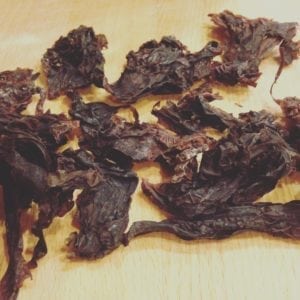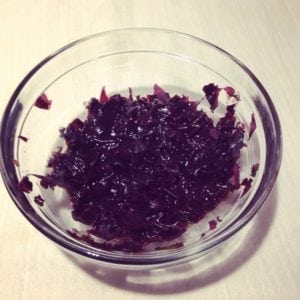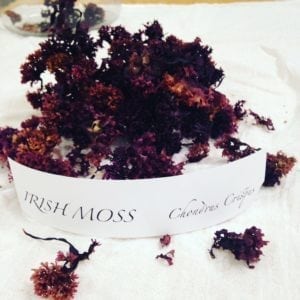Red Seaweeds: Herb of the Week
Continuing with our seaweed explorations from last week, this time we turn to the red seaweeds.
Introducing the Reds
First, who are we talking about? The red seaweeds we work with most often are dulse (Palmaria palmata), nori (Porphyra umbilicalis), and irish moss (Chondrus crispus). There are lots of others – about 7000 defined species in the red seaweed group, the Rhodophyta. Many red seaweeds live deep in the sea, much deeper than brown or green seaweeds – they’ve adapted to make use of the wavelengths of sunlight which penetrate to the depths; they know how to go deep.
Red seaweeds have similar functions to the brown seaweeds, but there are a few points of differentiation. For starters, the reds don’t have quite the same fiber profile as browns – they have more digestible fibers, as well as much more obvious mucliagens such as agar and carrageenan. Irish moss, for instance, is extremely rich in carrageenan and is one of the most mucilaginous herbs out there, whether on land or at sea. (And if you’ve worked with slippery elm, you know that’s saying something!)
In our experience, reds also have more rapid wound-healing capacity than browns. Nori is a standout for this purpose: topical applications (wraps or poultices) of nori will not only accelerate wound healing, but also relieve pain. Very helpful for a broken toe, as Katja can attest! A misstep during a plant walk led to her personal discovery of this aspect of nori medicine. There’s only the hard way. 😉
Dulse
Out of all the seaweeds, dulse is the one we recommend for folks who are new to eating seaweeds or are a little wary. Its flavor is milder than the others, much less “fishy”, with a nice umami/savory taste that is partly due to its high iron content. It’s also easy to eat in a variety of ways, including raw – it’s soft enough to eat straight out of the bag – or roasted into homemade seaweed chips.
Making your own roasted seaweed chips is easy! Just preheat the oven to 200 or 250 degrees Fahrenheit while you spread out some chip-sized seaweed pieces on a tray and brush them lightly with oil. Feel free to sprinkle some powdered herbs and spices over them as well. (You can even get fancy and marinate your seaweed in an herb-infused vinegar before you roast them. In this photo, I have a little bit of dulse marinating in Fire Cider. Experiment to see what you like best!) Once they’re prepped, pop them in the oven and roast for 10-20 minutes – stop when they have the texture you prefer. Longer roasting yields crispier seaweed chips. When dulse is prepared in this way, it just about melts in your mouth. Homemade snacks: that’s herbalism too, don’t you doubt it!
Dulse and the other red seaweeds also have a notable antiviral effect. Now, whenever you hear that an herb is antiviral, your next question should be “against which viruses?” No herb can fight -every- kind of virus out there in the world. In the case of the rhodophyta, they are particularly well-studied for efficacy against the herpes family of viruses: HSV1 & 2, shingles, chicken pox, etc.
Furthermore, the term “antiviral” is actually used in herbalism to mean two distinct categories of effect: one kind directly kills the virus or interferes with its replication, while the other actually stimulates your immune system to be more active in seeking out and destroying virally-infected cells. Red seaweeds seem to be capable of both types of effect: topical applications (poultices or seaweed wraps) applied to herpes lesions or cold sores will interfere with the viral life cycle in the skin, whereas eating the seaweeds stimulates immune activity systemically. Take it both ways, inside and out, for the best chance at success.
Irish Moss
Irish moss has a distinctive look to it, all spiky and fluffed. When you infuse it into water, though, it softens up and begins to ooze – it can make the liquid highly viscous. Or super gloopy, if you find that more descriptive!
Chondrus crispus is a seaweed most slimy. It is extraordinarily rich in carrageenan, a demulcent constituent whose name derives from carraigín, the Irish name for the seaweed. Everywhere it grows, the algae has long been included in ancestral recipes to thicken stews, gravies, puddings, custards, and all sorts of gelatinous, slippery stuff like that. Today, extracted carrageenan is used as a thickening agent in food products, including lots of “healthy” staples – it appears as an emulsifier in almond/coconut/hemp milk, for instance. Some people are sensitive to carrageenan when they encounter it that way, experiencing various intestinal discomforts, so check for that if you’ve already screened for common food allergies and are still having gut troubles.
Whole food preparations of Irish moss are very unlikely to cause the same kind of sensitivity, though, and in fact as an herbal remedy it’s extremely helpful in resolving inflammatory states and damage in the GI tract. The soothing, coating effects of Irish moss preparations can help if there’s an ulcer, particularly when cooked together with cinnamon and a bit of spice. Heal your gut!
Like many demulcent herbs, there’s a reflex effect when Irish moss is consumed, which directs more fluid to be released in the lungs. This thins mucous and makes it easier to expectorate, or else it simply moistens and soothes a tight, dry lung, whether from asthma, a smoking/vaping habit, or an infection. Loosen up and breathe deep!
The slime & fiber in Irish moss also helps with blood sugar regulation in diabetics, particularly when the seaweed is included in food. The complex polysaccharide goo simply slows down the rate at which you absorb sugars from your meal, so your blood sugar doesn’t rise up as high before insulin gets around to putting the sugar away in your cells. Furthermore, with long-term consumption of this or any other seaweed, beneficial changes to your gut flora will also serve to make you more metabolically flexible and capable of running on multiple different sources of fuel rather than just carbs.
Nori
Nori (Porphyra umbilicalis), when fresh, is a lovely reddish purple color – “porphyra” means purple in Greek – but it becomes green when it’s roasted, as the red/purple pigments are broken down. So, if your nori is green, you know it’s been roasted, cooked, or otherwise processed. It’s commonly made into sheets for wrapping sushi, in a process that’s basically identical to paper-making. That doesn’t make it worthless by any means! But I do like to eat a bit of raw nori now and again – it’s tougher than dulse, but totally doable.
In this photo, you see the before and after of dried nori left alone, soaked for 30 minutes, boiled for 3 minutes, or roasted for 10 minutes at 200°F. In the boiled seaweed in particular, you can see that the pigments are starting to break down, revealing the green underneath the red – like autumn in reverse.
Nori and the other red seaweeds are relatively high in protein, too – some red seaweeds get into the range of 30-40% protein by dry weight!
While not as demulcent as Irish moss, nori is yet a softening medicine. In its natural environment, it can be exposed to the sun and completely dry out when the tide goes out, and still come “back to life” when the tide comes in again. This is a good resilience medicine, and something to meditate on!
Known to Traditional Chinese Medicine as zicai, Porphyra species are considered to be sweet, salty, and cold in nature, and enter the Lung meridian; they soften hardness, dispel heat, and promote urination. Traditional indications for goiter and leg swelling are currently considered to be due to the iodine and B vitamin content of the herb, but a broader holistic view considers the capability of seaweed to improve hydration status and fluid movement throughout the body as well.
In our experience, nori is very good for strains & sprains, joint degeneration, and broken bones – sometimes we call it “sea comfrey” for this reason. Topical applications are the most direct for this, and out of all the seaweeds we’ve tried, we find nori to be the best choice. If you’ve got some pain and want to get moving again, try a nori compress!
As referenced in this week’s podcast (about back pain and fancy herbal sparkling drinks: two important parts of summer!), here’s a favorite remedy for back pain: nori and a hot water bottle, plus a pot of tea (in this case, ginger, chamomile, nettle, and tulsi). Simply rehydrate the nori for a few minutes and spread it out on the sore part of your back, and lay a good hot hot-water bottle on top. Then simply relax and let it soak in for 20-40 minutes. When you’re done, move gently – Katja describes some of her favorite back pain exercises in the pod as well. Find it right here, or else simply search for Holistic Herbalism Podcast wherever you get your podcasts.
Want to learn more about herbs that can make your life better? Check out our Materia Medica program – it’s a complete herbal toolkit to keep you healthy and strong!
1 Comments
Leave a Comment
You must be logged in to post a comment.

Join our newsletter for more herby goodness!
Get our newsletter delivered right to your inbox. You'll be first to hear about free mini-courses, podcast episodes, and other goodies about holistic herbalism.






[…] discussed include kelp & other seaweeds, licorice, violet, & chickweed, along with brief mentions of cleavers, red clover, calendula, […]